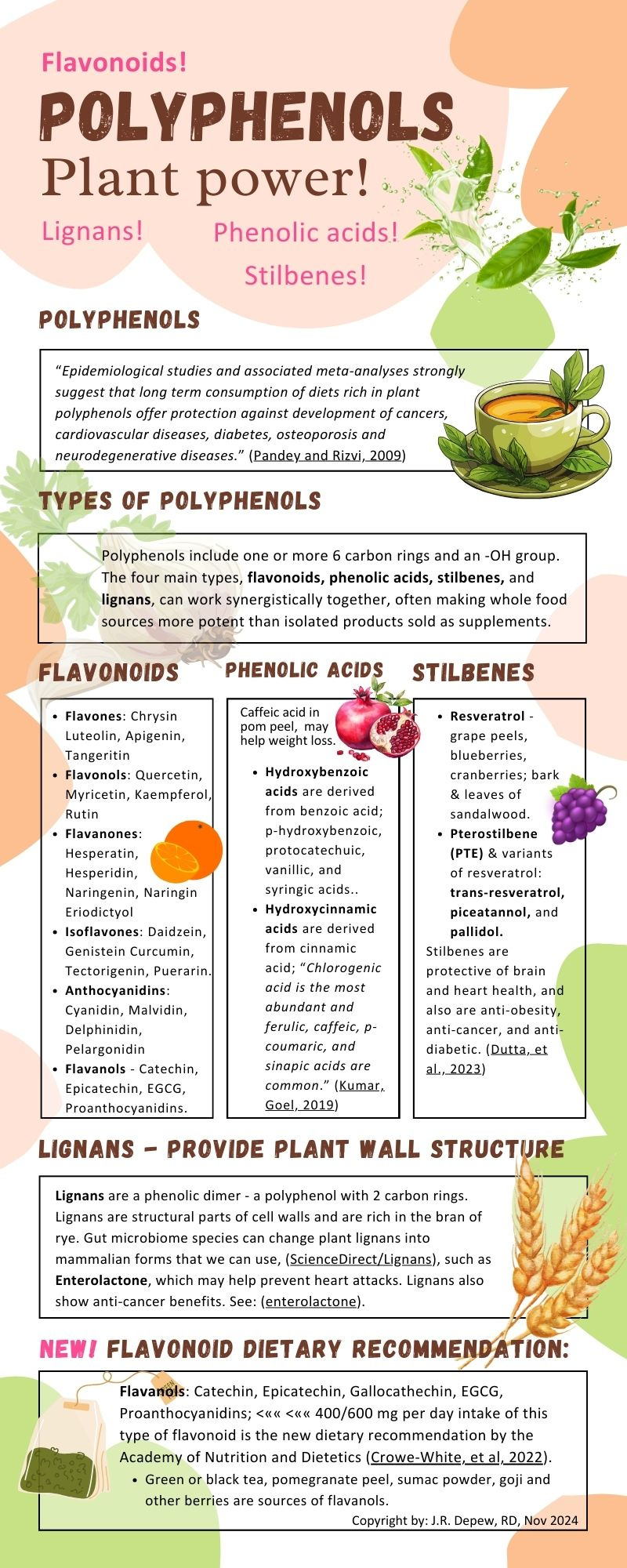Polyphenols - Plant Power; a new Infographic.
Types of polyphenols and common examples of beneficial polyphenol phytonutrients - flavonoids, phenolic acids, stilbenes and lignans.
New shareable infographic on polyphenol types and a little on the benefits. The pdf version has clickable links: (sync pdf).
“Epidemiological studies and associated meta-analyses strongly suggest that long term consumption of diets rich in plant polyphenols offer protection against development of cancers, cardiovascular diseases, diabetes, osteoporosis and neurodegenerative diseases.” (Pandey and Rizvi, 2009)

Polyphenols include four main groups:
Polyphenols include one or more 6 carbon rings and an -OH group - making them alcohols. The four main types, flavonoids, phenolic acids, stilbenes, and lignans, can work synergistically together making whole food sources more potent than isolated products sold as supplements.
Flavonoids
Flavones: Chrysin Luteolin, Apigenin, Tangeritin.
Flavonols: Quercetin, Myricetin, Kaempferol, Rutin.
Flavanones: Hesperatin, Hesperidin, Naringenin, Naringin Eriodictyol.
Isoflavones: Daidzein, Genistein Curcumin, Tectorigenin, Puerarin.
Anthocyanidins: Cyanidin, Malvidin, Delphinidin, Pelargonidin.
Flavanols - Catechin, Epicatechin, EGCG, Proanthocyanidins.
Phenolic Acids
Hydroxybenzoic acids are derived from benzoic acid; p-hydroxybenzoic, protocatechuic, vanillic, and syringic acids..
Hydroxycinnamic acids are derived from cinnamic acid; “Chlorogenic acid is the most abundant and ferulic, caffeic, p-coumaric, and sinapic acids are common.” (Kumar, Goel, 2019)
Caffeic acid from pomegranate peel may help promote weight loss.
Stilbenes
Resveratrol - grape peels, blueberries, cranberries; bark & leaves of sandalwood.
Pterostilbene (PTE) & variants of resveratrol: trans-resveratrol, piceatannol, and pallidol.
Stilbenes are protective of brain and heart health, and also are anti-obesity, anti-cancer, and anti-diabetic. (Dutta, et al., 2023)
Lignans
Lignans are a phenolic dimer - a polyphenol with 2 carbon rings. Lignans are structural parts of cell walls and are rich in the bran of rye. Gut microbiome species can change plant lignans into mammalian forms that we can use, (ScienceDirect/Lignans), such as Enterolactone, which may help prevent heart attacks. Lignans also show anti-cancer benefits. See: (enterolactone).
Flavanols: Catechin, Epicatechin, Gallocathechin, EGCG, Proanthocyanidins; <«« <«« 400/600 mg per day intake of this type of flavonoid is the new dietary recommendation by the Academy of Nutrition and Dietetics (Crowe-White, et al, 2022).
Green or black tea, pomegranate peel, sumac powder, goji and other berries are sources of flavanols.
**Addition: I made this into an X article which has a little more information about health benefits of proanthocyanidins.
See this post for some of the Reference List and more background information and foods sources.
Disclaimer: This information is being provided for educational purposes within the guidelines of Fair Use and is not intended to provide individual health guidance.






Many thanks. Great guide. I just finished Dr. Nancy Banks book on; “AIDS opium diamonds and empire” great book and she completely turns HIV on its head and recommends thiol-SH herbs like NAC, garlic, onions, leeks etc. All of which store energy in electrons which they can give the cell. Any more thiol herbs you can think of?
Great information! Great infographic!